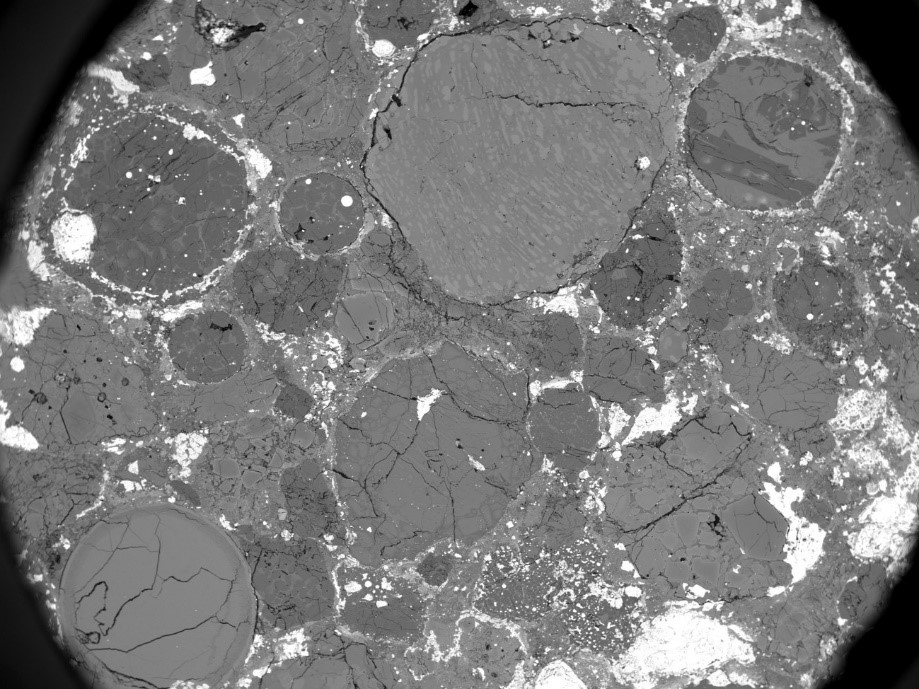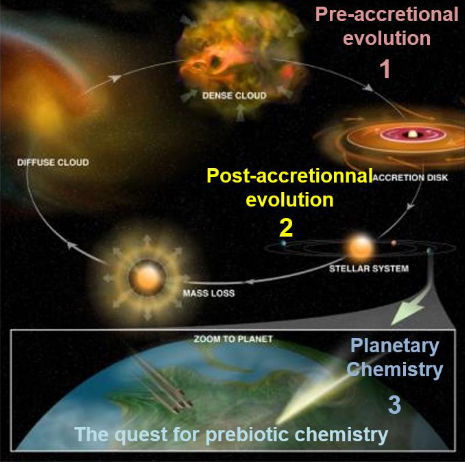
Thèse (CIFRE) : « Nano-caractérisation des volatiles dans les matériaux extraterrestres »
Thesis (CIFRE) : « Nanocharacterization of volatiles in Extraterrestrial Materials”

Paris
Légende photo :
SEM micrograph (BSE) of the Murchison meteorite. At the micron scale, metal alloys, sulphides, glass, silicates, clay minerals and organic matter coexist. The volatile content of each compound is hardly measurable these days. One of the objectives of this thesis is to develop analytical solutions to make these measurements possible.
© M. Roskosz
Postée le 26 février 2025
This thesis is part of a wider project COSMO-SAT (P.I. A.-M. Seydoux-Guillaume, Co-P.I. F. Vurpillot and M. Roskosz) from the PEPR Origins (https://pepr-origins.fr/projet/cosmo-sat-2/).
The objective of COSMO-SAT will be to develop a new generation of tomographic atomic probe dedicated to the analysis of geological and cosmological samples in order to significantly improve their quantitative and isotopic measurements at the nanometric scale. Measuring quantitatively the elemental and isotopic composition of samples, down to the atomic scale, allows to trace and quantify the irradiation processes and the gas-grain interactions in the protoplanetary disk, to determine the origin of pre-solar grains and their associated nucleosynthesis, as well as the origin of primitive complex objects such as GEMS (i.e. glass containing metals and sulfides). It will allow us to launch the first nano-geochronology studies on extraterrestrial samples. The project has several ambitious instrumental improvement objectives. One of them concerns the development of cryo-preparation of samples to improve the measurement of light atoms (H, He, C, …) volatile at room temperature and is at the centre of the present PhD.
The C-H-O-N-S-NG elements (NG=Noble Gases) that constitute the outgassed atmosphere of planets have likely been delivered by chondritic materials during planetary accretion and subsequently processed over billions of years of planetary differentiation. This implies that these elements were once stabilized in solid phases (metallic alloys, silicates, oxides, sulfides) in order to be transported over astronomical distances and durations. Although these elements are generally considered to be volatile, a large part of the accreted C-H-O-N-S-NG on planetary bodies are still sequestered in their cores and mantles. Taking the Earth as an example, the water present in the Solid Earth (metallic core + silicate mantle) represents more than 4 global oceans! Minerals are therefore a dominant reservoir of C-H-O-N-S-NG. However, the details of their accommodation and speciation within the structure of metals, silicates, oxides and sulfides are barely resolved because these elements are generally present at trace levels in substitutional or interstitial sites, or, as nanoscale precipitates. This constitute a major caveat in our understanding of the astrophysical cycle of these life-essential elements.
Objectives:
Recent technological advances in APT make it possible to detect volatiles such hydrogen, nitrogen, carbon and noble gases at trace levels in virtually all types of materials down to the nanometer scale. However, APT specimens need to be prepared as sharp needle tips, with an end diameter smaller than 100 nm. Preparation by focused ion beam (FIB) techniques may affect the stability of these elements in crystal structures because of beam damages and moderate temperature increases. In addition, due to the transience of volatiles, the air transfer of final specimen between FIB and APT instruments may also reduce their amount prior to analysis. As a result, representativity of APT data may be questioned. Over the past decade, advanced cryogenic fabrication methods in FIBs, and related vacuum transfer to final analysis chambers have emerged. They clearly offer the best solution to overcome the previous issues for volatile containing APT specimen preparation. Solutions are now commercially available, and can be fitted to commercial APT instruments.
The first aim of this PhD thesis is to contribute actively to the design, and implementation of such a cryo-transfer system to the COSMO-SAT instrument. The second aim of this thesis will consist in the commissioning of the new system. The main objective here will be to identify and analyze a series of relevant standards. A special emphasis will be put on the quantitative measurements of H and NG contents in known terrestrial and extraterrestrial samples through intercalibration with secondary ion mass spectrometry, infrared and Raman spectroscopies and noble gas mass spectrometry available in academic laboratories in France. By the end of this PhD, analysis of rare and precious extraterrestrial samples should be amenable and, in this context, the PhD student will be involved in the first quantitative APT studies providing decisive constraints on the astrophysical processes presiding to the accommodation of hydrogen and noble gases in minerals.
Profile:
Formation: Master in Material or Earth Sciences or engineering degree in physics/mechanics/materials science.
Skills: Strong interest and appetence for instrumentation and materials characterization. Motivation.
Application: Interested candidates should send a short CV (including the list of papers/communications) + a letter of motivation + a letter of recommendation, by email to Frédéric Danoix (GPM; frederic.danoix@univ-rouen.fr), Mathieu Roskosz (IMPMC/MNHN; mathieu.roskosz@mnhn.fr) and Laurent Roussel (CAMECA; Laurent.roussel@ametek.com)
Start: October 2025 (flexible on few months)
Working places:
Groupe de Physique des Matériaux (GPM) in Rouen (https://gpm.univ-rouen.fr/), and CAMECA (Genevilliers, France and Madison, USA), world leader in APT systems commercialization. Visit to other labs implied in the COSMO-SAT project (e.g. IMPMC/MNHN in Paris).
Plus d'actualités Postes à pourvoir


